Architects and builders have first-hand experience with the importance of exterior cladding for both aesthetics and energy conservation of a structure. Poor-quality materials and inefficient or even confusing installation requirements can wreak havoc on both short- and long-term performance of the building, its tenants or residents, and the reputations of the professionals who designed it.
It is for this reason that Acme Brick has added a premier cladding manufacturer to its list of suppliers.
CUPACLAD® Rainscreen Cladding is a sustainable and competitive solution that uses high-durability black slate and new fastening systems that take full advantage of the efficiency of ventilated façades. Many experts consider this natural slate to be the best cladding product in the world.
What This Means for You — Innovations in building envelope products and systems, such as the CUPACLAD Rainscreen Cladding, are changing the formula for successful building design. This has encouraged architects, builders, and their clients to want more information on this option.
All CUPACLAD slate is extracted and selected from the world’s largest reserves of natural slate in northwest Spain. The company’s 20 quarries in this region produce slate that’s considered by international experts to be of the highest quality and beauty.
Whether for a new home, the redesign of an older home, or commercial building construction, CUPACLAD should be considered. Click here for more information on this game-changing product.
What Is Rainscreen Cladding?
In recent decades, architects and builders have recognized rainscreen cladding as the most efficient cladding system for construction envelope purposes. This is a building solution that is consistent with current sustainable architecture trends.
For hundreds of years, architects have struggled to overcome the failings of poor façade insulation. This condition entails significant energy losses in both homes and commercial buildings. Finally, in 1963, Canadian architect G.K. Garden invented the first rainscreen system.
A rainscreen cladding system is made with a load-bearing wall, an insulation layer, and a cladding material that is fixed to the building using a supporting structure. This combination creates an air cavity between the load-bearing wall and the cladding material, allowing continuous ventilation.
The load-bearing wall must ensure the stability of the building. Whether made from brick, concrete, wood or other material, this wall must be stable enough to support the weight of the cladding and the wind loads transmitted through the structure. It must also support the weight of the cladding material.
The air cavity has top and bottom openings to allow the constant circulation of air. These openings must be correctly protected to prevent water infiltration, since water can diminish the efficiency of the insulating material. On the lower opening of the façade, a ventilated flashing is included to allow ventilation while preventing the entry of insects and small animals.
This unique cladding system allows year-round energy efficiency. As a result of temperature differences, a natural convection process known as the “chimney effect” takes place in this cavity. This convection process makes the warm air lift during the summer, pulling cooler air into the cavity.
During winter, the air inside the cavity is not warm enough to lift, which helps the insulation layer contain the heat inside the building. This chimney effect avoids overheating during the summer, and helps maintain a warm and steady interior temperature during the winter.
When combining the rainscreen cladding system with an exterior insulation system, CUPACLAD slate provides the building with numerous advantages, such as increased thermal and acoustic insulation. Plus, rainscreen cladding systems require almost zero maintenance, especially if the builder chooses a cladding material that can withstand adverse weather conditions, like a high-quality natural slate.
Vacation Home Makeovers
The energy efficiency of CUPACLAD rainscreen slate has made it extremely popular among commercial builders. However, this product is also receiving rave reviews from architects who redesign vacation homes.
According to this case study, an old summer lake house located on the outskirts of Minneapolis went through a total renovation. Charles Peterson, AIA LEED AP, Senior Project Designer at Aulik Design Group, said, “The performance of this home and the durable exterior shell are extraordinary. We designed and built the home in accordance with the Department of Energy’s Zero Energy Ready Home Program.
“It was important to select materials that were durable, sustainable, and beautiful. Aesthetically, we were searching for a cladding material that would work not only on the vertical planes but also on the roof planes.”
“CUPACLAD offers opportunities for residential designers and builders to get very creative,” noted Raven Tschida, CUPACLAD’s US Marketing Manager. “Our product line can be specified for modern, traditional, or mixed-media design exteriors. These specs can be for exterior rainscreen or direct-apply applications. The horizontal slate modules can be integrated with just about any high-performance exterior material, and they are easy to install.”
Stunning Design Options
CUPACLAD Design offers several possibilities for designing ventilated facades using new forms and combinations of natural slate. Here are six design options to consider.
HONEYCOMB
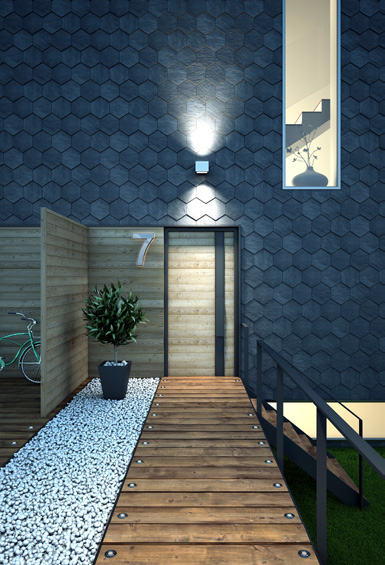
Using hexagons for exterior design is timeless, and they are also trendy for contemporary architecture. The Honeycomb design has been inspired by nature and uses the hexagon shape. Of course, the hexagon is seen all around us—in turtle shells, beehives, and even snowflakes! Hexes have become an inspirational pattern in contemporary architectural design as they offer a refreshing, natural look that is easy on the eye. The honeycomb design is easy to install and is suitable for all shapes of buildings.
DIAGONAL
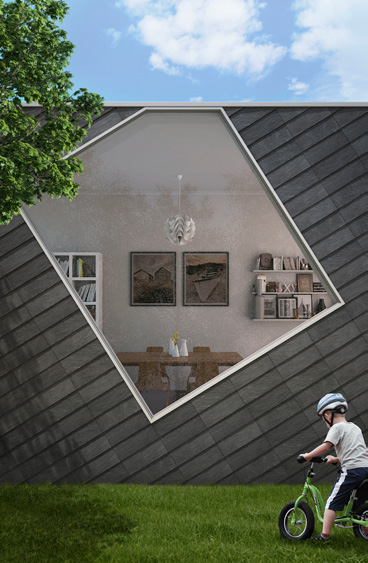
The diagonal design, inspired by a simple rectangular geometric format, offers a touch of exclusivity. This design also creates an elegant, spontaneous, and elaborate look while also offering efficiency and durability. The CUPACLAD Diagonal design is suitable for lengthy, low- to medium-height buildings. The design inclines towards the sky, which creates a height-to-width ratio, offering buildings a dynamic, slender look.
LINEAL
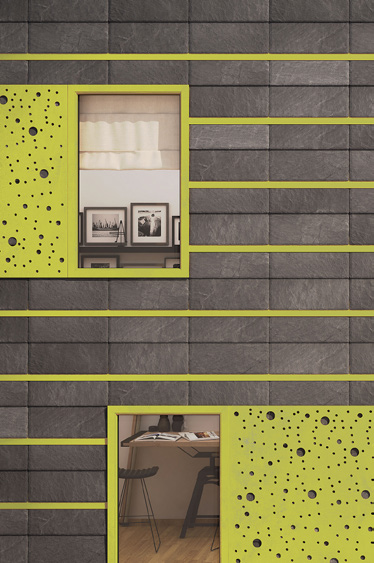
The new CUPACLAD Lineal design proposal differs from the other rainscreen cladding designs in that it suggests a combination of patterns and creates a touch of light. The design has been developed to introduce new colors and textures, making the façade stand out and become a distinguishing feature. The design can be used partly or fully on the façade, depending on the architect’s desired visual preference.
ASCENT
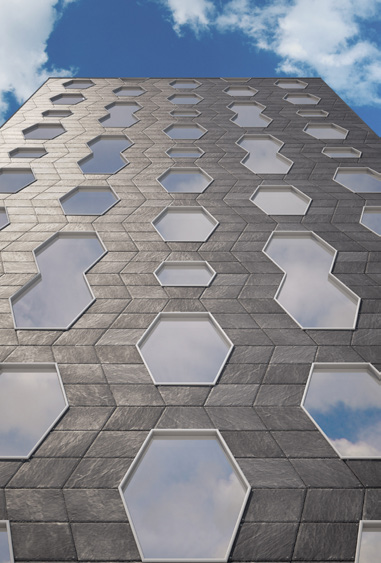
A combination of rhomboid and trapezoid shapes makes up the Ascent design. The fixing of this design includes 4 stainless steel flat-headed screws, designed by the CUPACLAD R&D team, and 4 fasteners per piece. When installed on lengthy buildings, the façade creates a dynamic and volumized look that is influenced by the combination of shapes. Using the rhomboid and trapezoid shapes not only creates movement on the façade but it demonstrates the possibilities of using different shaped slates and allows architects to design more freely to suit all trends and demands.
SHIELD
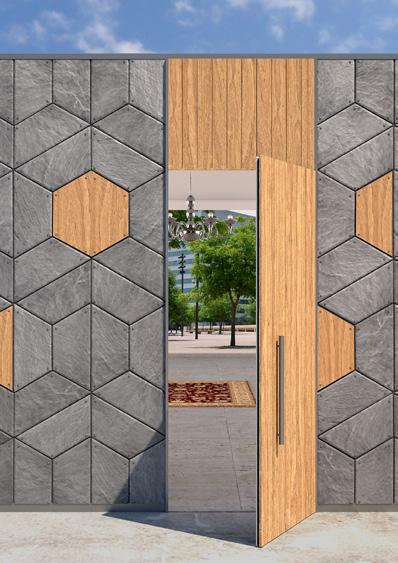
The CUPACLAD Shield design allows an architect to combine natural slate with other materials, offering the opportunity to create a unique and trendy façade to suit their demands and design preferences. The suitable materials are wood, metal, or colored ceramics. This design uses 60x26 cm isosceles trapezoids installed with visible stainless flat-headed screws, designed by the CUPACLAD R&D team.
WAVE
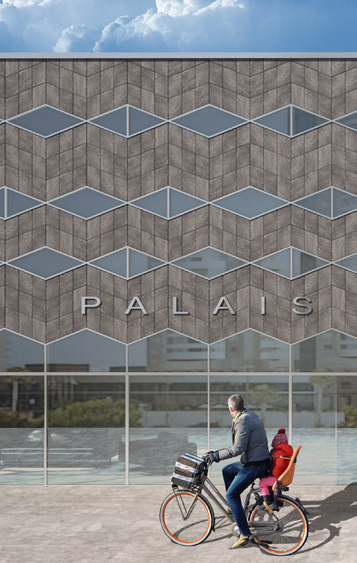
The zigzag shape evokes the movement of the sea, offering a wave-like effect. This feature creates a dynamic and original façade, standing out for its unique characteristics and exclusive personality. The CUPACLAD Wave design uses a rhomboid shape suitable for horizontal buildings such as convention palaces, museums, concert halls, etc. This design includes 4 visible stainless flat-headed screws per slate and does not require an overlap between slate pieces.
World Class Building Products
Acme Brick has been serving the construction industry for more than 130 years with its iconic clay brick. As new innovations in building engineering and architectural design are introduced, the company has expanded its product offering. CUPACLAD is one of those products that is changing the way buildings are becoming more energy efficient and sustainable.
If you are looking for the next energy-saving, sustainable, natural product, click here to get more information on CUPACLAD slate cladding.

